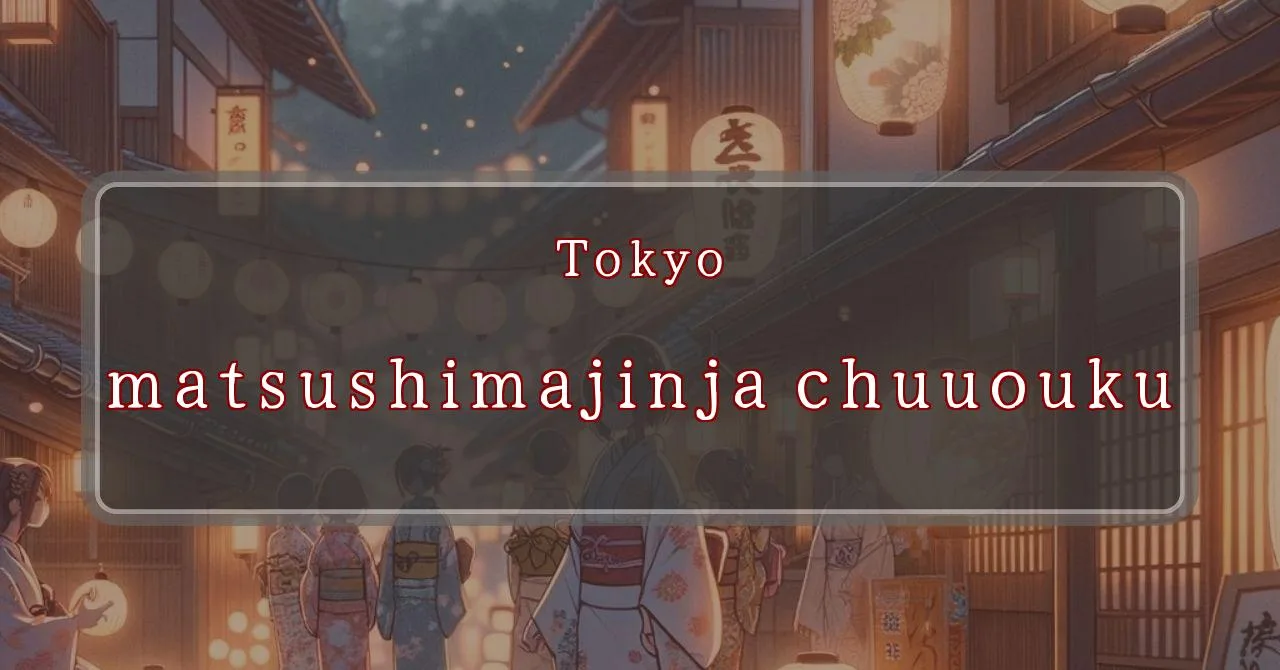Enchanting lights illuminate the night at Matsu-shima Shrine
Basic Information
Matsu-shima Shrine is a Shinto shrine located in the Nihonbashi Ningyocho district of Chuo Ward, Tokyo, Japan.
- Address: 2-15-2 Nihonbashi Ningyocho, Chuo-ku, Tokyo 103-0013
- Phone Number: 03-3669-0479
- Access: 5-minute walk from人形町駅 (Ningyocho Station) on the Tokyo Metro Hibiya Line or Toei Asakusa Line, 2-minute walk from水天宮前駅 (Suitengu-mae Station) on the Tokyo Metro Hanzomon Line, 7-minute walk from人形町駅 (Ningyocho Station) on the Toei Asakusa Line, 10-minute walk from浜町駅 (Hamacho Station) on the Toei Shinjuku Line
- Festival Days: May 15th, November酉の日 (酉の日 is the Day of the Rooster, which occurs 12 times a year in the Japanese calendar)
Main Events and Attractions of the Festival
The Matsu-shima Shrine Festival is a lively and colorful event that attracts many visitors each year. The main events and attractions of the festival include:
Mikoshi Procession
One of the highlights of the festival is the mikoshi procession. A mikoshi is a portable shrine that is carried through the streets by a group of people. The Matsu-shima Shrine mikoshi is a large and elaborate structure that is decorated with colorful tapestries and carvings. It is carried by a team of over 100 people, and its progress through the streets is accompanied by music and dancing.
Kagura Performance
Kagura is a traditional Japanese dance that is often performed at Shinto festivals. The kagura performance at the Matsu-shima Shrine Festival is a highlight of the event. The dancers wear elaborate costumes and masks, and their movements are graceful and fluid. The performance tells the story of the shrine’s founding and the history of the local area.
Food Stalls
No Japanese festival is complete without food stalls! At the Matsu-shima Shrine Festival, there are many stalls selling a variety of delicious foods, including traditional Japanese dishes like yakitori (grilled chicken skewers), takoyaki (octopus balls), and taiyaki (fish-shaped cakes filled with sweet bean paste). There are also a number of stalls selling souvenirs and crafts.
Fireworks Display
The Matsu-shima Shrine Festival concludes with a spectacular fireworks display. The fireworks are launched from a barge in the Sumida River, and they light up the night sky with their brilliant colors. The fireworks display is a fitting end to a lively and enjoyable festival.
Blessings and Deities
Matsu-shima Shrine is dedicated to a number of deities, including:
- Inari Ōkami: The deity of rice and agriculture
- Izanagi-no-Mikoto: The male deity who created the Japanese islands
- Izanami-no-Mikoto: The female deity who created the Japanese islands
- Susanoo-no-Mikoto: The god of storms and the sea
- Ōkuninushi-no-Mikoto: The god of nation-building and prosperity
- Sarutahiko-no-Ōkami: The god of roads and travel
- Kotohira-no-Ōkami: The god of seafaring and fishing
- Amaterasu-Ōmikami: The sun goddess and the most important deity in the Shinto pantheon
- Daikokuten: The god of wealth and fortune
Visitors to the shrine can pray to these deities for blessings such as good health, prosperity, and success.
Origin and History
The origins of Matsu-shima Shrine are unclear, but it is believed to have been founded in the 14th century. The shrine was originally located on a small island in the Sumida River, but it was moved to its current location in the 17th century. The shrine was destroyed by fire in the Great Kanto Earthquake of 1923, but it was rebuilt in 1929.
Tips and Notes for Visitors
- The Matsu-shima Shrine Festival is held on May 15th and November酉の日 (酉の日 is the Day of the Rooster, which occurs 12 times a year in the Japanese calendar). The festival features a mikoshi procession, a kagura performance, food stalls, and a fireworks display.
- The shrine is open daily from 9:00 AM to 5:00 PM. Admission is free.
- The shrine is located in a busy area of Tokyo, so it is best to visit during the week or on weekends when there are fewer crowds.
- There is a small parking lot available for visitors to the shrine.
Parking Information
There is a small parking lot available for visitors to the shrine. The parking lot is located on the north side of the shrine, and it can accommodate about 10 cars. The parking fee is 500 yen per day.
Popular Stalls and Food Carts in Recent Years
| Type of Stall | Description |
|---|---|
| Takoyaki | A staple at Japanese festivals. Characterized by a crispy outside and a creamy inside. |
| Jaga Butter | A simple yet popular snack of hot potatoes lavishly topped with melted butter. |
| Baby Castella | Small castella cakes, sweet and fluffy treats enjoyed by children and adults alike. |
| Grilled Ayu with Salt | Fresh ayu fish grilled whole with salt, a savory taste of Japanese summer. |
| Shaapin | A unique gourmet item influenced by foreign cuisine, with a chewy skin wrapping the filling. |
| Okonomiyaki | A Japanese grilled dish where you often choose your own ingredients for a personalized flavor. |
| Cotton Candy | A fluffy, sweet snack that’s extremely popular with children. |
| Chocolate Banana | A banana coated in chocolate, a fun and visually appealing dessert. |
| Kushiyaki | Various types of ingredients skewered and grilled, an easy-to-enjoy snack. |
| Yakisoba | Fried noodles mixed with a special sauce, a fast food favorite in Japan. |



